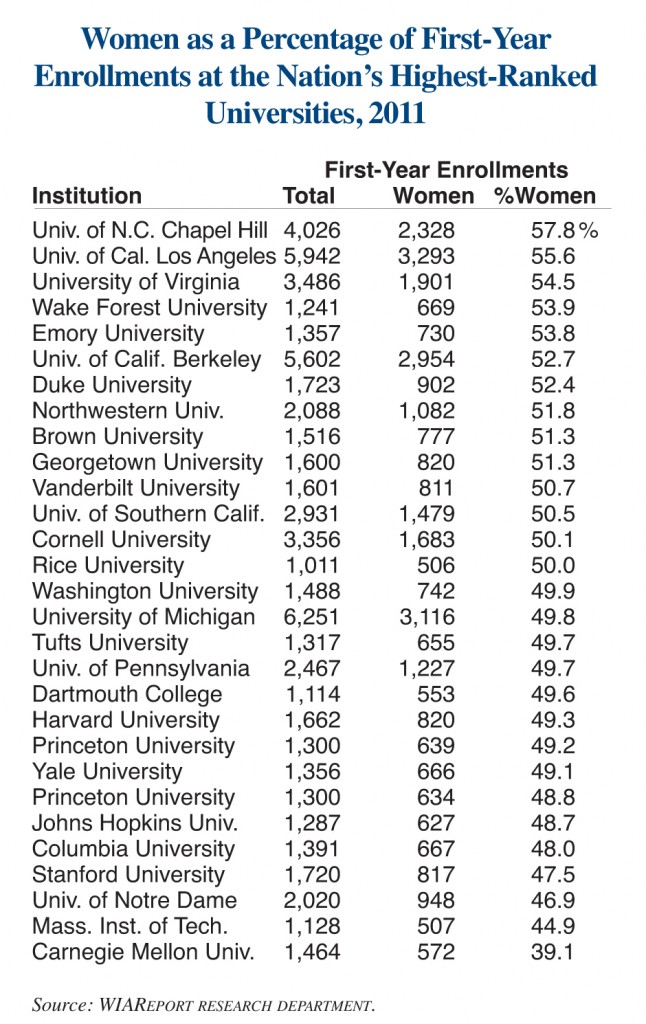WIAReport Survey: First-Year Enrollments of Women at the Nation’s Leading Research Universities
Posted on Nov 22, 2011 | Comments 1
 WIAReport surveyed the nation’s highest-ranking research universities to determine the percentage of women in this year’s entering classes. Of the 29 high-ranking universities that responded to our survey, women were a majority of the entering students at 14 schools while there were more men than women in the entering classes at 15 universities. However, the results showed a wide disparity.
WIAReport surveyed the nation’s highest-ranking research universities to determine the percentage of women in this year’s entering classes. Of the 29 high-ranking universities that responded to our survey, women were a majority of the entering students at 14 schools while there were more men than women in the entering classes at 15 universities. However, the results showed a wide disparity.
At the University of North Carolina at Chapel Hill, there are 2,328 women in the entering class compared to 1,698 men. Therefore, women make up 57.8 percent of all first-year students. This is the highest percentage of women among the entering classes at the nation’s leading research universities.
While the number of women may seem high at UNC, it must be remembered that women make up 56.7 percent of the total enrollments at all four-year institutions of higher education in the United States. The University of North Carolina at Chapel Hill is the only one of the nation’s most prestigious research universities where the percentage of women in the first-year class is higher than the nationwide average for women enrollments.
Among the large research universities, UCLA has the second highest percentage of women in its entering class. Women make up 55.6 percent of all first-year students at UCLA. At the University of Virginia, women are 54.5 percent of the first-year students.
At Wake Forest, Emory, Berkeley, and Duke women make up at least 52 percent of the students in the current entering class.
At Carnegie Mellon and the Massachusetts Institute of Technology, two institutions where there are a large number of students in STEM disciplines, women make up far smaller percentages of all entering students. At Carnegie Mellon, women make up 39.1 percent of the first-year class. At MIT, the figure is 44.9 percent.
Stanford and the University of Notre Dame are the only other two high-ranking research universities that responded to our survey where women were less than 48 percent of all entering students this fall.
Filed Under: Enrollments • Gender Gap • News









This is good news, and one can probably conclude that equal access has been achieved at the level of undergraduate education. Still, the percentage of women phd students is smaller than undergrads, and the % of women full profs is still scandalously low. what happens?
Admission to medical school in Norway is based on an elaborate point system. High school grades, work experience, even age can give applicants more points and thereby increase their chances.
Lately I’ve heard informal discussions about adding a new criterion for points. Perhaps male applicants should get an extra point or two — just for being a man!
Incoming classes in medical schools in Norway have recently had about 70% female students. For some, the over-representation of women at this level gives hope.
Their hope reveals an argument I call THAW — Time Heals All Wounds. If we just wait, according to THAW, the large numbers of women entering medical school will lead to greater numbers of women professors and greater numbers of women in leadership positions.